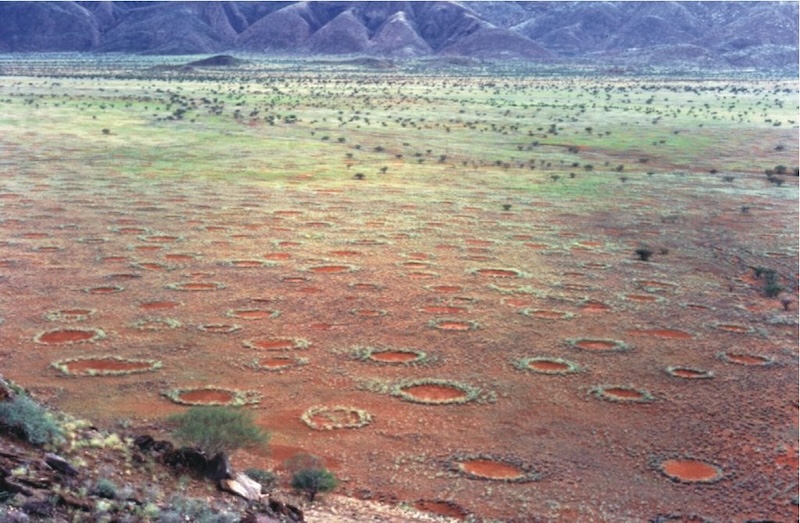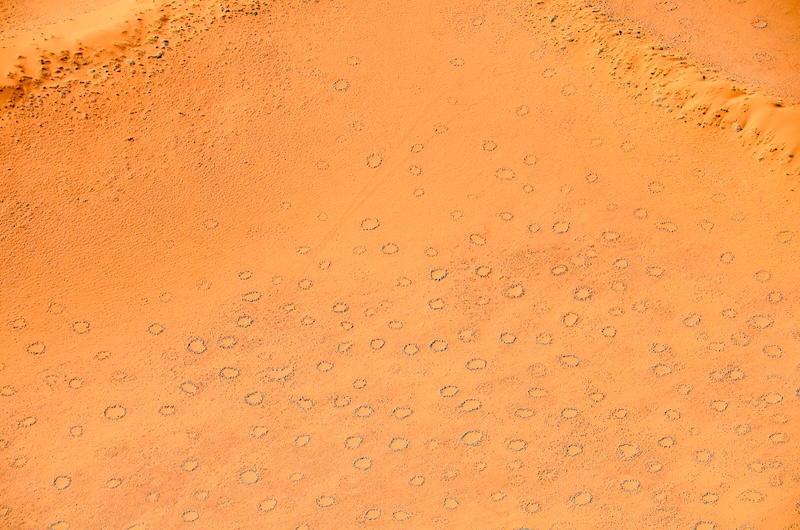
Fairy circles aren’t to be confused with fairy rings. Fairy rings are rings or arcs of mushrooms, found mostly in forests and sometimes in meadows. Fairy rings are created by a fungus. Fairy circles, on the other hand, are round patches in arid vegetation. They’re found in the Namib Desert in southern Africa, and in the outback of Western Australia. The origin of fairy circles isn’t entirely understood. But the first study of fairy circles on a global scale has revealed hundreds of them.
Fairy circles can come in clusters. And scientists still aren’t exactly sure what causes these clusters of circular patches on arid grasslands, although termites, or competition between grasses, are two possibilities. In mythology, people thought that gods, spirits or natural divinities caused fairy circles, which were sometimes called the “footprints of the gods.” Now, it seems that fairy circles might be more widespread than previously thought. An international team of researchers using artificial intelligence (AI) has discovered 263 additional locations for fairy circles in 15 countries around the globe. Victor Tangermann wrote about the puzzling discovery in Futurism on September 30, 2023.
And the researchers published a new peer reviewed paper about the fairy circles in the journal Proceedings of the National Academy of Sciences on September 25.
The 2024 lunar calendars are here! Best Christmas gifts in the universe! Check ’em out here.
Satellite images and AI reveal fairy circles in hundreds of locations
Until now, fairy circles were known to exist only in Africa’s Namib Desert and in a remote part of the large, dry Pilbara landscape in the Australian outback. But now, it seems the phenomenon may be much more widespread than previously known. So how did the researchers find all these other fairy circles?
First, they used satellite images of Namibia and Australia, about half of which contained known fairy circles. They then fed those images – more than 15,000 of them – into a neural network. In neural networks, AI teaches computers to process data in a way that mimics the human brain. Then, the team used the same AI system to analyze satellite image of more than half a million other locations around the world. Each location is a 2.5 acre plot of land. And voila! The AI system identified apparent fairy circles in 263 additional locations in 15 countries, located in areas including Africa, Madagascar, Western Asia and Southwest Australia.
As the paper explained:
Fairy circles (FCs) are regular vegetation patterns found in drylands of Namibia and Western Australia. It is virtually unknown whether they are also present in other regions of the world and which environmental factors determine their distribution. We conducted a global systematic survey and found FC-like vegetation patterns in 263 sites from 15 countries and three continents, including the Sahel, Madagascar and Middle-West Asia.
This is the first study to map fairy circles on a global scale, as the paper mentions:
Our study provides insights into the ecology and biogeography of these fascinating vegetation patterns and the first atlas of their global distribution.
Is it the same phenomenon?
Are these circles really the same as the other fairy circles? Like those ones, all the newly-found circles are in hot, sandy areas. Some scientists are doubtful, however, that all the circles have the same cause. Futurism quoted Norbert Jürgens, an emeritus ecologist at the University of Hamburg, as saying:
In all arid regions of the world various types of bare patches exist, which are caused by different processes.
He first offered his opinion in an article in The New York Times on September 26, 2023.
The new research isn’t meant to be too competitive, though, as co-author Fernando Maestre, an ecologist at the University of Alicante in Spain, noted:
We are not trying to fight with anyone.
There is also still much debate over just what a fairy circle is. As of now, there isn’t really a clear consensus. Michael Cramer, an ecophysiologist at the University of Cape Town in Africa, added:
Unfortunately, the only guardians of the term ‘fairy circle’ are self-appointed.

Possible explanations
Given that there isn’t a firm consensus on how fairy circles form, there are various theories being debated. One possibility is that termites beneath the surface create them. Another idea is that the plants involved self-organize into the circular spots as a result of competition between different types of grasses. Scientists have also suggested radioactive soil or plant toxins.
It’s also quite possible that there is more than one explanation, as co-author Emilio Guirado at the University of Alicante in Spain said:
I think that the world can be complex and that all the hypotheses of the formation of fairy circles could have a place depending on the site or the moment.
It is likely that all of them are valid where they have been described and that some could be combined in a few places at once. For example, our results show that the importance of termites is greater in the Namibian zone than in Australia or the Sahel zone.
More specialized fieldwork is required to provide more information and results on the formation of these intriguing vegetation patterns.
Interestingly, the circles in Namibia form in areas with sand, while the ones in Australia are in regions with clay. This also suggests possibly more than one formation mechanism.
Bottom line: Here’s the 1st study to map fairy circles on a global scale, suggesting these circular patches in arid ground are more widespread than thought.
Source: The global biogeography and environmental drivers of fairy circles











